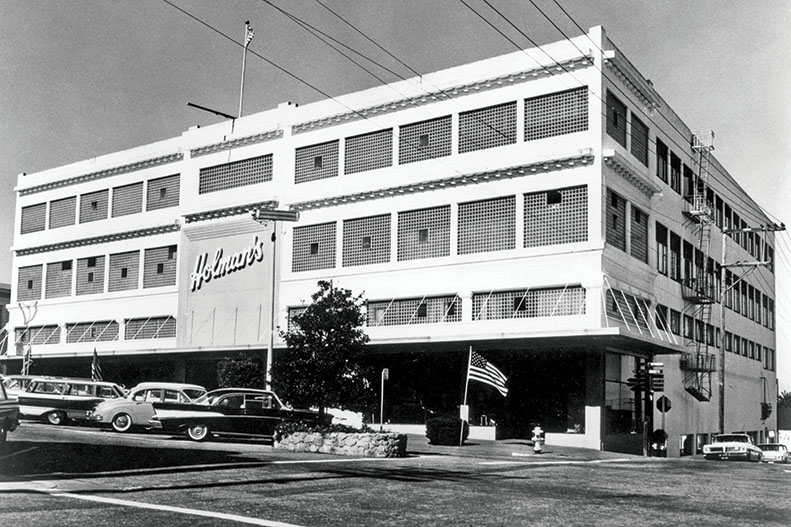
In 1938, two years before winning a Pulitzer Prize for “The Grapes of Wrath,” John Steinbeck typed a letter to Zena Holman. Zena and her husband, Wilford Rensselaer (W.R.) Holman, had transformed their family’s Pacific Grove dry goods shop into a retail destination with 46 departments and some 200 employees. Steinbeck was recommending a friend for an advertising job at Holman’s Department Store.
“I feel a little self conscious in writing to you in as much as I have never met you,” Steinbeck’s letter says. “Ritchie Lovejoy has, I believe, applied for a position in the advertising department of Holman’s. I know that he is capable and energetic and trained [in] the field.”
After praising Lovejoy’s knowledge and skills, Steinbeck admits he has never written this kind of reference.
“There must be rules for recommending a man to a job, but I have never learned them. I hope that you will seriously consider Mr. Lovejoy for this position,” he writes.
The correspondence is one of four Steinbeck letters that editor Heather Lazare included in “My Life in Pacific Grove,” a May release that chronicles W.R. Holman’s life. The book’s text dates to 1979, when the then 95-year-old businessman dictated his life story to his caretaker, Louise V. Jaques. Lazare edited and annotated that memoir for the recent release, supplementing the story with 150 vintage photographs, newspaper clippings and images of store memorabilia.
Lazare’s husband, Ben, is Holman’s great-grandson. After his mother passed away in 2015, 15 tubs of family memorabilia landed in the couple’s Pacific Grove garage. Lazare started sorting through boxes during the pandemic shelter-in-place orders.
“I was still working full time, we had two kids at home, and my husband was getting his master’s degree and student teaching. But we were all here with nowhere to go, so I just took out one box at a time,” she says. “I’m not an archivist, but I like to organize and I love history. And this all felt very relevant, because these are my children’s relatives.”
Lazare had long considered updating Holman’s original book. In 1979, the businessman purchased a mimeograph machine and published his memoir for a small circle of friends and family members. Lazare’s neighbor later shared a copy with Patricia Hamilton of Park Place Publications, who encouraged Lazare to tackle the project. Joyce Krieg, Hamilton’s colleague, typed up the decades-old text and sent over an electronic file.
“I had Patricia saying, ‘Hey, you should do this.’ I was organizing all these boxes. And suddenly, I had a Word document I could work with. I was in my zone,” says Lazare, who edited books at Random House and Simon & Schuster before launching her editorial consulting business. “I looked at everything we had and added context to what W.R. Holman and his caretaker had put together. Those photos were just sitting in our garage, where no one was ever going to see them. The book offers an enjoyable way to view everything.”
The 312-page volume is organized in three sections, starting with Holman’s original text. Lazare rearranged some pieces to present his stories more chronologically, but she didn’t change his words. (“I can’t insert cultural sensitivity into history when it didn’t exist,” she writes in the introduction, referencing any outdated terms that might make modern readers pause.)
In those early chapters, Holman describes his ancestors’ journey from Vermont to California via a four-month boat trip around the southern tip of South America. He documents his childhood in Pacific Grove, where the family moved after his mother passed away. He shares memories of boardwalk paths on Monterey’s Alvarado Street, stagecoach trips to Big Sur, and his father’s local business ventures—including the evolution of their eponymous department store.
The book’s second section contains the Steinbeck letters. In one handwritten note from 1948, the novelist addresses his slow reply to previous correspondence.
“Sorry to delay answering your letter, but as a look at my [Holman’s] account will show, I have been painting and fixing the little cottage my father built on 11th St before I was born,” Steinbeck writes.
The letters are followed by media coverage and details on Holman’s various projects, from abalone conservation campaigns to holly-farming adventures. Many of the holly trees in Pacific Grove grew from starters he sold or gave to community members. Holman also advocated for a road between Pacific Grove and Carmel. That stretch of Highway 68 opened in 1930 and, in 1972, was dedicated as the W.R. Holman Highway.
“He worked really hard to get that highway constructed,” Lazare says. “He actually walked the surveyors along the route he used to take his horse from Pacific Grove, through the forest, to Carmel Valley.”
The book’s third section spotlights Holman’s late 1920s efforts to enact Pacific Grove’s city charter, followed by Lazare’s closing comments on his life and work.
“This book covers a hyper-local topic, but it’s also relevant for anyone who has lived on the Monterey Peninsula, shopped at Holman’s in the past, or walked by that building and wondered about its history. The family’s story is a very American one,” she says.
With the book completed, Lazare is focused on scanning and storing some final media clippings, large-format negatives, property deeds and other documents that once filled her garage. “Organizing the materials was satisfying,” she explains, “while guiding the book to publication feels surreal.”
“Preserving these materials is so important, not just for me, but for my children,” she says. “I want them to know about their relatives, even if they can’t meet them. This has all been about being able to say, ‘Would you like to know more about your great-great grandparents? Here is the book.'”
“My Life in Pacific Grove” is available in hardcover, paperback and e-book formats through several local bookshops and online retailers. Proceeds from the book will support Friends of the Pacific Grove Library. For more information, visit the Pacific Grove Books imprint of Park Place Publications at www.lifeinpacificgrove.com.